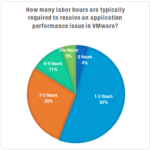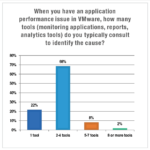This is the second blog post in a two-part series examining challenges IT teams face in optimizing application performance and other issues in VMware environments. The original text of this series appeared in an article on Data Informed.
In part one of this series, we uncovered that IT teams are currently using multiple tools to understand application performance issues in VMware. Read on to learn about the other challenges IT teams are facing in virtual environments
Application Performance Issues Are Eating Away at Time and Resources
While IT professionals are consulting their VMware environment application monitoring tools, critical hours are ticking by. For smaller businesses that have limited IT staff, this can cause considerable delays in day-to-day operations. IT teams cannot afford to waste time chasing false positives or focusing their energy on areas of the environment that are not truly the root cause of their application performance issue. Additionally, many IT teams are inundated by alerts from their VMware environment monitoring tools, making it difficult to pinpoint which alerts are meaningless and which are worth diagnosing to solve a potential application performance issue.
These interruptions are significant, considering that our recent survey found more than half of IT professionals are facing applications performance issues every month. Additionally, 44 percent indicated that it takes them more than three hours to resolve application performance issues as they arise. Overall, it’s clear that IT teams are frequently facing issues in VMware environments, and they are wasting critical manpower and resources solving these issues.
The Causes of Application Performance Issues Remains a Mystery.
Despite the wide variety of tools available and the volume of time spent solving business-critical application performance issues, IT professionals remain uncertain they can attack these problems head-on. Of the IT professionals surveyed, only 20 percent believe the strategies they implement to resolve application performance issues are 100 percent accurate the first time. Even more alarming, seven percent would characterize their application performance issue resolutions as an “educated guess.” And across the board, it is rare for IT teams to implement a perfect solution to a performance issue– they frequently require a level of adjustment or even a complete rework.
What’s Next?
This trend towards moving business-critical data off of physical servers and onto virtual environments will continue for the foreseeable future, and the relationships between VM applications, network devices, storage devices and services will only grow more complex. Many CIOs are turning to machine learning solutions to help them better understand their infrastructure and learn to optimize the relationships that exists between the different IT disciplines. As a result, the core approach used by IT professionals are changing from a traditional computer science approach to a data science-centric approach. We’ve also seen the rise of “AIOps” or algorithmic IT operations platforms in the last year. A term coined by Gartner to describe machine learning applications in IT, Gartner estimates only five percent of businesses currently have AIOps platforms in place. However, that number is expected to mushroom to 25 percent in the next two years as IT becomes increasingly complex and difficult to manage.
Read Roadblocks to Optimizing Application Performance in VMware Environments part one




